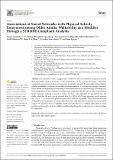| dc.contributor.author | Asiamah, Nestor | |
| dc.contributor.author | Agyemang, Simon M. | |
| dc.contributor.author | Yarfi, Cosmos | |
| dc.contributor.author | Muhonja, Faith | |
| dc.date.accessioned | 2024-01-11T12:26:59Z | |
| dc.date.available | 2024-01-11T12:26:59Z | |
| dc.date.issued | 2023-02-14 | |
| dc.identifier.uri | https://doi.org/10.3390/ijerph20043341 | |
| dc.identifier.uri | https://repository.amref.ac.ke/handle/20.500.14173/899 | |
| dc.description.abstract | Abstract
The available evidence suggests that social networks can contribute to physical activity (PA) enjoyment, which is necessary for the maintenance of PA over the life course. This study assessed the associations of active and sedentary social networks with PA enjoyment and ascertained whether walkability moderates or modifies these associations. A cross-sectional design compliant with STROBE (Strengthening the Reporting of Observational Studies in Epidemiology) was employed. The participants were 996 community-dwelling older Ghanaians aged 50 years or older. A hierarchical linear regression analysis was used to analyse the data. After adjusting for age and income, the study found that the active social network size (β = 0.09; p < 0.05) and sedentary social network size (β = 0.17; p < 0.001) were positively associated with PA enjoyment. These associations were strengthened by walkability. It is concluded that active and sedentary social networks may better support PA enjoyment in more walkable neighbourhoods. Therefore, enabling older adults to retain social networks and live in more walkable neighbourhoods may be an effective way to improve their PA enjoyment. | en_US |
| dc.language.iso | en | en_US |
| dc.publisher | International Journal of Environmental Research and Public Health. | en_US |
| dc.title | Associations of Social Networks with Physical Activity Enjoyment among Older Adults: Walkability as a Modifier through a STROBE-Compliant Analysis | en_US |
| dc.type | Article, Journal | en_US |

